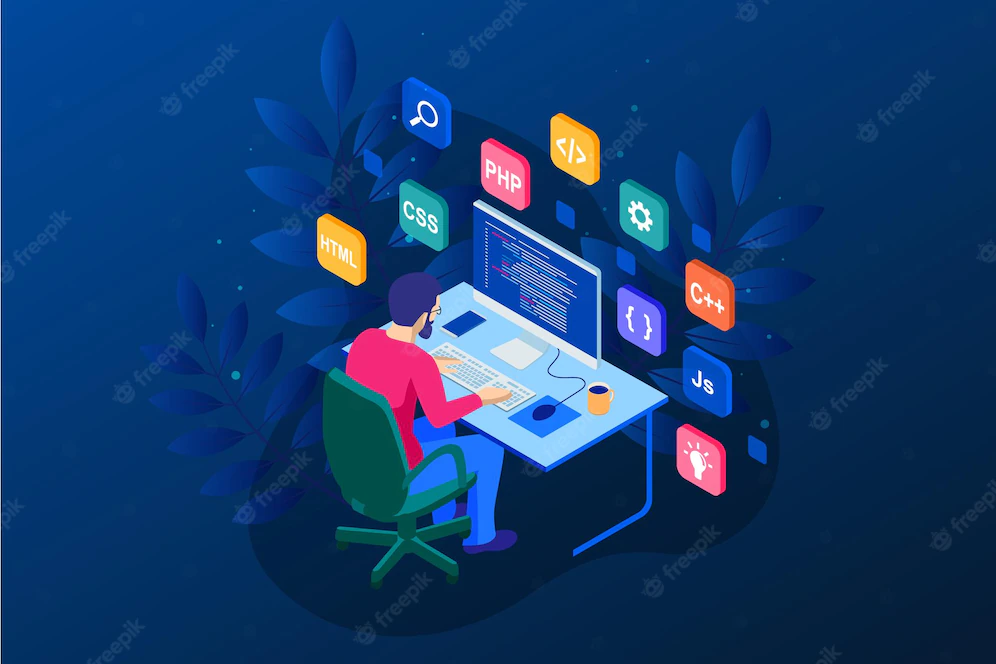
Every website, every app, and every piece of software people use today has been built by a web developer. As a result, web development has become a very lucrative career path with some web developers bringing in six figures per year. Because a lot of our modern lives happen online, web developers are in high demand across various industries today.
If you’ve ever thought of making a foray into a new career as a web developer, then this blog is for you. Today, we’re talking about everything you need to know about becoming a web developer. Let’s get started!
Web development is the process of building and maintaining websites, apps, and software operating on the internet. Web developers use a variety of coding languages to ensure that a website not only looks visually pleasing but also provides a seamless user experience.
Typically, web development is categorized into the front end, back end, and full-stack development.
Front End Development focuses on the design elements of a website while anticipating user behavior and needs. Front-end developers don’t create the design of a website, instead, they use coding language to translate visual elements into lines of code that users see as static and interactive objects on their screens.
Front-end developers often collaborate with graphic, UX, or web designers to transform design ideas into a website, app, or piece of software that is easy to use. They also ensure that a website is optimized for search engines so people can find them. They also make sure that a website works and looks good regardless of screen size by incorporating responsive design elements. Lastly, a front-end developer tests websites and fixes bugs and other issues that might arise.
Some of the coding languages used in front-end web development include:
Back-end development involves the behind-the-scenes systems and structures that allow web pages, applications, and software to perform smoothly. While users don’t interact with the server-side of web apps, these inner workings ensure that they are functional, efficient, and fast.
Back-end web developers are responsible for a number of things including understanding the goals of a website and coming up with effective solutions to reaching these goals. Back-end development also includes storing data and ensuring that it is displayed to users who need to access it. The back-end side of web pages also includes developing payment processing systems, particularly for e-commerce websites, and integrating systems for accepting data, securing information, and making payments.
Furthermore, back-end developers also manage API resources and ensure that they work across a wide range of devices design the architecture of systems, and are involved in data science analyses. They also organize the logic system that runs across various devices, implement algorithms and solve system-related problems, manage hosting environments, database administration, and scaling applications to handle changes in load, and take care of version control.
In terms of coding languages, back-end developers often use:
Full-stack development refers to the development of both the client-side and the server-side of web applications. Developers with full-stack skills can work on the frontend, backend, database, and debugging of web applications or websites.
Full-stack developers choose “stacks” or various programs and coding languages to build a fully fleshed-out web application. The choice of which stack to use depends on the goals of the current project he or she is working on. Some of the most popular stacks include:
It’s important to note that while full-stack developers can build both the front and back-end of a website or application, they don’t necessarily have to do it. The point of understanding both the client-side and server-side coding processes, they can jump in and solve issues on both ends when the need arises. This is particularly useful for big projects that involve a team of programmers.
A web developer’s primary duty is to create a website that is visually appealing, easy to navigate, and runs smoothly. Depending on their role, web developers can have different tasks.
Back-end web developers oversee creating a website’s structure, writing its code, and verifying that the code works through performing tests. They may also manage access points for others who need to manage the content of a website.
Front-end web developers work on the visual part of the website. They don’t necessarily come up with the design for the website. Rather, they write the code that makes up the user interface. This can include the physical layout of each page, the graphics that need to be integrated, and the interactive elements like buttons, tables, and dropdown menus.
Full-stack web developers on the other hand can do both the work of a front-end and a back-end developer. If a project is small enough, they can build the entire website on their own. Otherwise, if they’re working with a group of developers, they can provide solutions to both front-end and back-end issues that might arise.
A web developer may also act as a webmaster or as a website manager. In this case, their primary role is to keep a website updated in terms of content and to ensure that all the links and applications on each page are working properly.
Web developers may also have general tasks which include but are not limited to:

Web development can be a flexible field that offers many opportunities for professionals. Here are some of the things you need to do to become a web developer:
If you’re interested in a career in web development, you first must possess the skills necessary to for the job. These technical skills will serve as a strong foundation for you as a service provider:
Learn programming languages like HTML, PHP, CSS, JavaScript, Python, and Ruby. These are foundational languages that can get you started in building successful websites and apps.
Static websites are a thing of the past. Most people expect that a website will work and look great no matter what screen size they use to view it. Take the time to learn about responsive design to make sure that your websites look good on a phone, a tablet, and a computer screen.
SEO helps in ensuring that your website comes up on search engine results pages.
“We don’t just sell websites, we create websites that SELL.”
― Dr. Christopher Dayagdag
This skill allows you to track and control any changes made to your source code, so you don’t have to start from scratch when an issue comes up.
You can learn these skills in school by pursuing a formal degree in web development or computer science. However, it’s not always necessary. There are online courses available from which you can learn the fundamentals of web development.
Apart from technical skills, you also need to have soft skills that will improve your marketability as a service provider. This includes:
As a web developer, you’re going to spend a lot of time discussing ideas with designers, team members, and your clients. You need to know how to effectively get your message across to prevent any misunderstanding.
Little details matter when it comes to writing code. As a web developer, you need to have a keen eye for details to prevent performance issues on the apps and sites you build.
Web developers may need to juggle different projects at once. So you need to know how to effectively keep track of your deadlines, manage your project tasks and workflow, and work within a budget to effectively complete your websites.
Web development largely relies on a developer’s problem-solving skills. Bugs are bound to happen, so you need to be able to identify issues in your code and provide the necessary solution.
“Let us take you into a deeper experience, make a moment a lasting conveyable memory. Let us help build your tribe.”
― Deep Immersion
Your portfolio is an important part of your resume. Clients often want to see what you’ve previously worked on so they can determine if you’re a good fit for them. Include samples of your work that represent the kind of work you like to do.
While getting web development certifications isn’t mandatory, it’s still a great way to market your skills to potential clients. By getting certified, you can:
Some certifications you can pursue include Adobe Certified Expert (ACE), Microsoft Certified Solutions Associate (MCSD), Amazon Web Services (AWS) Certified Developer or Zend Certified PHP Engineer.
Web development is a profitable career option especially if you have a passion for building aesthetically pleasing and highly functional websites and web apps.
By knowing the fundamentals of web development and continuing to educate yourself on the current best practices, you can land high-paying clients in no time.
Ready for a simple future Let’s get Started!
Leave Your Comment